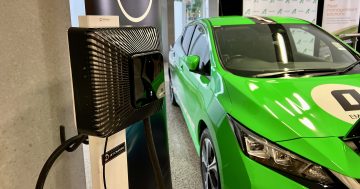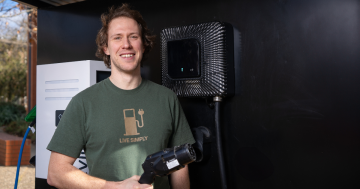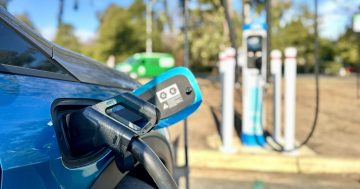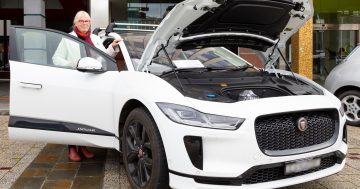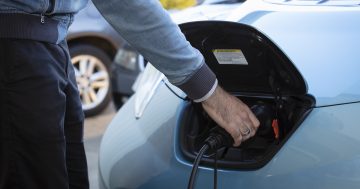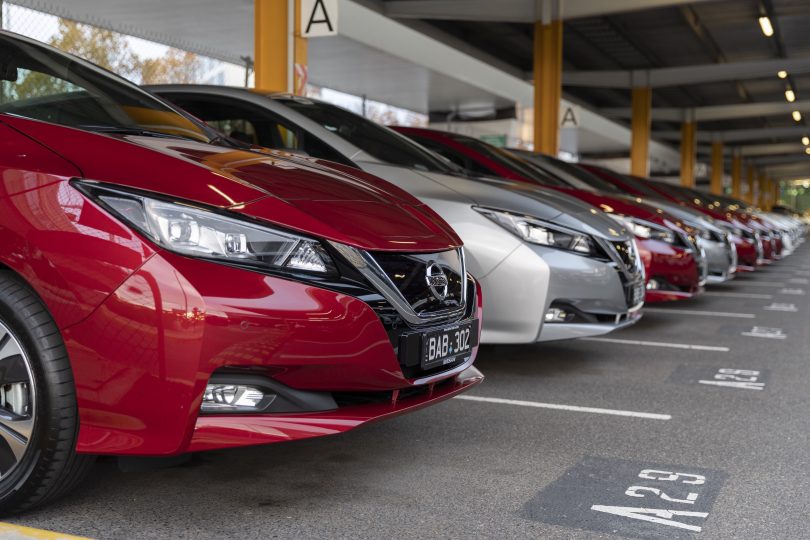
The Nissan Leaf bi-directional vehicles that will be purchased by the ACT Government. Photo: Supplied.
In a world first, the ACT is trialling how electric vehicles can improve energy resilience during peak demand times by providing power from their batteries back into the grid.
The $6.6 million Realising Electric Vehicle-to-grid Services (REVS) project is occurring in partnership with organisations across the electricity and transport supply chains.
The trial will see the ACT Government purchase 50 new Nissan Leaf bi-directional vehicles.
“If the project is successful, fleet owners will be paid for putting electricity from their car batteries back into the grid. In the future, we hope this can extend to Canberrans’ privately owned electric vehicles,” Acting Minister for Climate Change and Sustainability, and Minister for Advanced Technology and Space Industries Mick Gentleman said.
“This has the potential to improve financial incentives for buying electric vehicles, which will be crucial for reducing ACT’s transport emissions. The new system could be particularly beneficial during times of peak power usage as a way of balancing renewable energy delivered into the grid.”
ActewAGL was awarded $2.4 million as part of the Australian Renewable Energy Agency’s (ARENA) Advancing Renewables Program, with the group manager of product and strategic energy deployments Todd Eagles saying the trial will quantify the value of the bi-directional energy flow available from electric vehicles.
“When electric vehicles are plugged into a bi-directional charger, the vehicle owner can be financially rewarded for providing energy back into the grid when it’s needed, making electric vehicles an even more attractive proposition, especially for fleet owners,” said Mr Eagles.
The ANU’s Distributed Energy Lab will also be used in the V2G (vehicle-to-grid) project that research lead Dr Bjorn Sturmberg said has the potential to enable a more resilient energy system with higher levels of renewable energy, like rooftop solar.
“We know V2G works in the lab but we need to demonstrate the reliability and viability of V2G services in the real world at scale,” Dr Sturmberg said.
“We need to prove the control, coordination, and cybersecurity of the technology systems, as well as the crucial business and regulatory models to make V2G attractive to all stakeholders,” Dr Sturmberg said.
“As a stepping stone to the field deployment, the project will leverage the state-of-the-art grid simulation facility at the ANU. This will allow the charger to be rapidly prototyped to respond to the frequency disturbances that occur when the grid is on the brink of a blackout.”

Dr Byron Sturmberg, of the ANU, will lead the research. Photo: ANU.
According to Dr Sturmberg, the ultra-fast reactions of EV batteries make them extremely adept at balancing the grid.
“One EV battery typically contains as much energy as an average household uses over two-to-four days and can react to events in a tenth of a second,” he said.
“If all of Australia’s 19 million vehicles were electric, they would store more energy than five Snowy 2.0s, or over 10,000 Tesla Big Batteries.”
It’s hoped the research will help transform electric vehicle charging from a challenge for the grid into an asset that boosts energy reliability and security.
The Australian Government, through ARENA, is providing the ACT Government with an $885,000 grant to assist with the purchase of the 50 vehicles, state-of-the-art bi-directional chargers and associated electrical works. A further $2.47 million of ACT Government funding will provide for 50 Nissan Leaf 2.0 vehicles and electrical works to prepare ACT Government buildings to receive electricity from the vehicles.
The REVS project is a whole-of-industry collaboration including the ACT Government (fleet owner), the ANU (research), ActewAGL Retail in partnership with Evoenergy (electricity network owner), JET Charge (charging infrastructure), Nissan (vehicle manufacturer) and SG Fleet (fleet manager). Project partners have supported the project by contributing a further $3.86 million. Accenture is supporting the REVS project with project management services and insights on the global EV landscape.
The project will run until February 2022.












